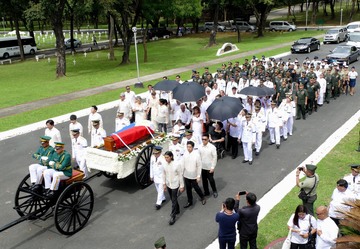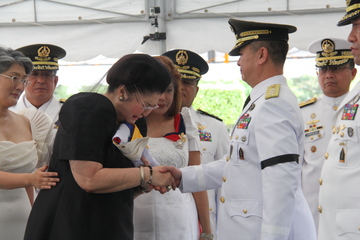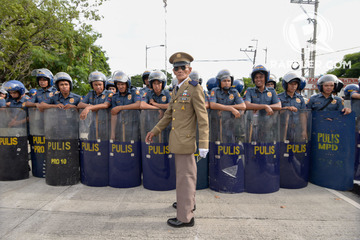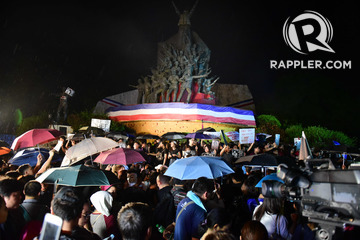MANILA, Philippines – On a late night helicopter ride on February 25, 1986, the late dictator Ferdinand Edralin Marcos, his family, and select government officials fled Malacañang Palace, on the third day of the People Power Revolution.
On Friday, November 18, thirty years after the revolution that ousted Marcos, his son, daughters, and grandchildren alighted from military helicopters, fresh from the Libingan ng mga Bayani, where Marcos had just been granted a hero's burial replete with a peaceful and private ceremony.
Seated by the military chopper's open side door, former senator Ferdinand Marcos Jr's white barong glistened as the dark-colored aircraft landed on Villamor Air Base past 1 pm that Friday. He alighted on one side of the chopper, while his sister Irene got off from the other side, the skirt of her white Filipiniana dress flapping against the swirl of the chopper's blades that were slowing to a halt.
Ilocos Norte Governor Imee Marcos, hand in hand with son Borgy Manotoc, led another group of the family that emerged from a second chopper.
Together, the heirs to the loyalty and loathing of a divided Filipino people, walked toward the Villamor Air Base VIP Lounge as the media watched and waited for a statement that Imee would deliver.
"Sa wakas, napatupad sa araw na ito ang huling habilin ng aking minamahal na ama, ang ating Pangulong Ferdinand Edralin Marcos: na maihimlay kasama ng kanyang mga kapwa sundalo. Ang aking pamilya ay taos-pusong nagpapasalamat sa inyong lahat na nagpatotoo sa karapatan niyang mahimlay sa Libingan ng mga Bayani," she said while the rest of the family stood in the background.
(Finally, the final wish of my beloved father, our president Ferdinand Edralin Marcos, was realized on this day: that he be buried along with his fellow soldiers. My family whole-heartedly thanks all of you who stood by his right to be buried at the Libingan ng mga Bayani.)
She thanked President Rodrigo Duterte first and foremost in the statement that took less than a minute. The family then left the venue without entertaining questions.
The armed forces helped make that solemn day possible.
The military delivers
The private burial is a testament to the efficiency of the armed forces when it commits itself to a goal. On Friday, they were determined to give Marcos a peaceful ceremony.
"We always defer to the wishes of the family or the next of kin. After all, sila po ang ang may namatayan (they're the ones who are burying loved ones). We provide the services as long as it is a legal order," said Armed Forces spokesman Brigadier-General Restituto Padilla.
The order came from no less than the commander-in-chief, Rodrigo Duterte, who pledged during his campaign that he would allow Marcos to be buried at the Libingan. Martial law victims asked the Supreme Court to stop the burial, but the High Court junked their petitions.
Duterte gave the orders to proceed with the burial as soon as the Supreme Court gave the go signal. But he would be absent on the day itself.
The military claimed they were told at 5 pm the previous day only, about the Marcos family's wish to bury their patriarch at 12 noon on Friday, November 18. Military officers held a meeting that night and it took them 12 hours to prepare, according to Padilla.
"We were given very short notice, at exactly 5 o'clock yesterday the first word reached us and hence a flurry of activities," said Padilla.
It is not clear what time the military chopper left Manila for Ilocos in the early morning of Friday. But before 9 am, the chopper had picked up Marcos' remains and headed for the Libingan, where it arrived past 11 am with time to spare before the ceremony at 12 noon.
The military honored Marcos with the usual pomp and pageantry that it gives its dead soldiers. Acting Armed Forces chief Lieutenant General Glorioso Miranda led the arrival honors and a short march to bring the small brown wooden coffin that carried Marcos' remains to the entombment area.
Generals in their elegant white duck uniforms served as ceremonial pall bearers. Marcos' children and grandchildren paraded in white barong and Filipiniana, while Imelda, who is as loved and loathed as Marcos himself, stood out in her black gown and her wheelchair.
Soldiers then carried on their shoulders the small coffin to an entombment area exclusive to former presidents. Beside the gravesites of Elpidio Quirino, Carlos Garcia, and Diosdado Macapagal, a short program led by a military chaplain followed. Photos that were released showed a wreath from Duterte standing at the center of the burial site that the Marcos heirs themselves prepared.
"It was very solemn," said Padilla.
Afterwards, the flag was folded and the highest-ranking officer present – the military's No. 2, Armed Forces vice chief of staff Lieutenant General Glorioso Miranda who was serving as acting chief of staff – handed it over to Imelda.
She broke down as she held the flag close to her heart with one hand, while the other hand gripped Miranda's in a handshake, as seen in a photo released by the military. (READ: Top military generals absent at Marcos burial)
The final honors were rendered. The deafening 21-gun salute was heard from a distance. The usually heart-wrenching sound of the taps was played and a volley of shots was fired. "This is a salute, a final salute to any soldier who is laid to rest," said Padilla.
The short notice wasn't a problem. Padilla said preparations were already made before the Supreme Court ordered a halt to activities while the justices deliberated. Besides, the military has dedicated troops who practically do nothing else but honor dead soldiers. It was only a matter of bringing them to the ceremony.
Key to the success of the private burial was its secrecy. Indeed, news of the burial did not come out until about a few hours before noon. The night before, however, there was already word that the burial would happen over the weekend.
The two military choppers that flew Marcos' remains from Ilocos straight to the Libingan, and the Marcos heirs from the Libingan to Villamor Air Base where their statement was delivered, also protected Marcos and his family members from protesters.
Protests outside Libingan
Outside the Libingan were small groups of protesters, loyal supporters, and the media who rushed to the site as soon as they heard the news. It was no longer the responsibility of the military, whose tasks were limited to inside military facilities only such as the Libingan and Villamor Air Base.
The police, who also learned about the burial Thursday afternoon, took care of guarding the exterior, especially from protesters out to disrupt the ceremony that, to them, the dictator did not deserve.
"A lot of things are going to happen today," was all that Philippine National Police chief Director General Ronald dela Rosa said early Friday. He was en route to the arrival of alleged Eastern Visayas drug lord Kerwin Espinosa from Abu Dhabi.
Before proceeding to the Senate for budget deliberations, Dela Rosa paid a quick visit to the Heroes' Cemetery – a confirmation of suspicions that a Marcos burial was afoot that day.
Camp Crame officials said they began coordination with Police Regional Office 1 officials only on Friday morning itself. Another high-ranking police official said they were told of the need to preposition Civil Disturbance Management (CDM) personnel between midnight to 1 am also on Friday.
Events happened very quickly.
By late afternoon in Manila, Duterte would defend the fulfillment of his campaign pledge as protests spontaneously erupted nationwide, perhaps the biggest so far, under this new administration. (READ: Duterte on Marcos burial; Let history judge, I followed law)
The protesters vowed that the rallies would go on until Bonifacio Day on November 30. The loyalists are set to make a show of strength over this weekend, too.
Duterte said the burial would heal a divided country. But it didn't. It forced the crack even more wide open. – Rappler.com















